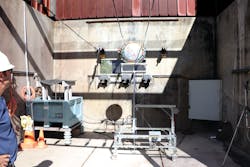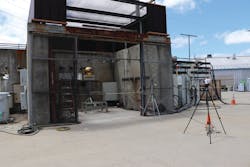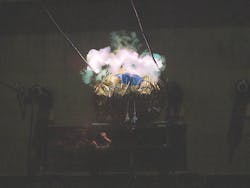SDG&E Fights Foil Balloons with Prototype
Every day, 3.6 million people in San Diego, California, U.S., and Southern Orange counties depend on SDG&E to power their homes and businesses. The utility works hard not to let them down. In fact, for 14 consecutive years, it has been recognized by PA Consulting for outstanding reliability performance in the Western U.S. To maintain this track record, the utility has invested in innovative technologies.
One innovation San Diego Gas & Electric (SDG&E) is pursuing will help to reduce outages caused by foil, or Mylar, balloons. Foil balloons floating into power lines are a common cause of outages in the utility’s service territory. In 2012, it launched a program to pursue the design and testing of a safer balloon prototype to reduce the impacts foil balloons have on power lines.
Although shiny and festive, foil balloons are made of electrically conductive material, which is a fundamental problem for power lines. Based on a polyester film, the balloons cause the most problems during spring and summer holidays and events, such as Valentine’s Day, Mother’s Day, Father’s Day and school graduations.
Impacts on Infrastructure
In populous areas of Southern California, SDG&E customers experienced more than 100 outages caused by foil balloons in both 2017 and 2018 — more than 5% of all outages during that time. Other California electric utilities experience hundreds of power outages from foil balloons, as well. For example, Southern California Edison (SCE) customers have experienced more than 200 outages in a single month — nearly seven outages per day — caused by these metallic foil balloons. What a big repercussion for such a small object.
However, the costs and risks of foil balloons go beyond the power outages customers experience. Another consequence is damage to infrastructure. When a fault occurs on an overhead distribution line, the line could come down and transformers could be destroyed. The costs to repair and replace these assets could approach US$1 million dollars per year. These costs ultimately would be passed on to utility customers through higher rates.
In addition to service interruptions and repair costs, foil balloons hitting power lines can increase fire risks. SDG&E has reported fires caused by balloons every year from 2014 to 2018. In 2018 alone, eight fires involving or near SDG&E equipment were started by foil balloons. While SDG&E installs protective devices that identify surges and isolate power to these areas to prevent damage to the electric system, foil balloons still pose an ongoing hazard. Although the protective devices may limit damage to electrical infrastructure, the short circuit could cause equipment explosions or the balloon material could catch fire and cause ground ignitions.
Nonconductive Technology
SDG&E’s work on balloons is not done in isolation. It is part of the utility’s larger strategy to enhance safety and reduce wildfires. As the threat of fires has increased in California in recent years, SDG&E has pioneered cutting-edge technologies and programs to monitor and forecast weather and fire conditions, hardened the power grid, and built extensive community partnerships to improve emergency preparedness and response.
At the same time, the utility continually invests in grid upgrades and day-to-day operations to reduce the frequency and duration of power outages. SDG&E’s grid is well equipped with high-tech sensors, automated controls, and switches that enable grid operators and field crews to detect and isolate problems quickly and restore power if an outage occurs. Equally as important is the utility’s culture of innovation among employees. Ultimately, this innovative spirit is the reason why SDG&E is now working on a more technologically advanced balloon.
In 2012, SDG&E employees set out to develop a method to make a nonconductive foil balloon that would not react to conduct electricity at grid voltages. The team worked with thin-film experts to develop the design and a large balloon manufacturer to develop prototypes. In 2019, the prototypes were tested in high-voltage electrical labs.
The nonconductive balloon development effort took into consideration that any revised design should provide an attractive alternative to Mylar balloons. For example, the materials had to accept inks of different colors for balloons commemorating various events. They also needed the ability to contain helium for a significant period, while maintaining an overall shiny, mostly opaque appearance. These properties, including compatibility with existing manufacturing methods and equipment, and a much lower electrical conductivity guided the development of the new prototypes.
The patented methods focused on patterning the metal so the balloon was still shiny yet not conductive, and so it would still hold helium inside. By depositing the metal in disconnected islands, rather than a continuous foil, the prototypes still had all the shiny appeal of standard foil balloons but would not create a hazard to power lines. Finally, the ability to tolerate sustained contact with high voltage needed to be confirmed and tested.
Test, Test and Test Again
In January 2019, the National Electric Energy Testing, Research and Applications Center (NEETRAC) at Georgia Tech ran tests on these nonconductive foil balloons at 12 kV and low impedance, simulating live grid conditions. The new balloons withstood contact with the two phase-to-phase conductors for five minutes without causing a fault. Retail foil balloons also were tested and caused an electrical short immediately, as expected.
Two months later, in March 2019, SDG&E ran similar tests, putting the new nonconductive foil balloons into energized overhead lines on SDG&E’s nominal 12-kV system. These were tests within a section of the actual grid but in a controlled environment at SDG&E’s skills training center, and only after all customer load had been transferred to other sections of the grid. Fire response teams were on standby but did not need to act. More than 10 balloons were tested without a single fault occurring.
A few months later, in June 2019, SDG&E worked with the Applied Technology Services lab at Pacific Gas & Electric Co. (PG&E) to test the nonconductive balloons at 21 kV, one of the nominal distribution voltages used across much of California. The new prototype balloons were raised into the conductors, sometimes in bundles, to span the increased gap between the conductors at these higher voltages. The balloons withstood 21 kV under simulated grid conditions for five minutes without causing a fault. Additional tests were applied using more aggressive conditions, including decreased conductor spacing and with salt fog, simulating an airborne contaminant. The new balloons passed all tests without causing a fault.
The Institute of Electrical and Electronics Engineers (IEEE) currently is creating a new test standard for evaluating the conductive properties of balloons. The draft standard is being developed by the Power & Energy Society within the distribution reliability working group task force.
The goal is to have an independent standard by which any balloon can be tested under conditions simulating the electric distribution grid, to determine whether a balloon is conductive. New testing methods will demonstrate the importance of developing nonconductive balloons and facilitate the development of enhanced safety standards for balloon manufacturers. Overall, new balloon safety requirements could be established to reduce service interruptions and protect public safety.
About the Author
Stephen T. Johnston
Stephen T. Johnston is the growth development manager at San Diego Gas & Electric (SDG&E) and has surreptitiously become a world-leading expert on nonconductive balloons. He is a member of the IEEE Power & Energy Society. Prior to working at SDG&E, Johnston had various business and engineering roles in high-tech and semiconductor companies in the United States and the United Kingdom. He has a master's degree in physics from Rochester Institute of Technology and an MBA degree from London Business School.




